I saw the light from the other guy’s headlamp bobbing through the trees so I waited until he was within hailing distance. He’d passed me earlier in the evening—I was already standing in the water by then—enroute to his spot a bend or two downstream.
“How’d you do?” I called.
“Not great,” he said. “A couple of small ones.”
We fell into step on the narrow trail leading out to the parking area, our headlamps coring the dark.
“It was weird that there weren’t more rising fish,” he continued. “The hatch was decent, then after the duns came off there was a spinner fall.”
More Like This
I was a little confused by that. As the crow flies we couldn’t have been more than 100 yards apart, but where I was standing the hatch was sparse and if there was a spinner fall I must have been having a Senior Moment at the time. Still, if there’s one thing I’ve learned about fishing the Hex hatch it’s that a minor difference in geography can make a huge difference in one’s experience of the event. There was the night on the Bois Brule years ago when my buddy in the other canoe claimed to catch 13 browns while I was catching two, although in light of subsequent revelations I strongly suspect he was bullshitting me.
Anyway, I was willing to give this guy, who struck me as “young” although he was probably in his 40s, the benefit of the doubt.
“Well,” I said, “I was here last night and there were fish rising all over the place. I caught six, although none of them were big. I heard a better fish working later on, after the hatch had wound down, but he was tight to some brush and I could never get him zeroed in. I came back tonight hoping for another crack at him.”
“Did you get one?”
“I did,” I said, the two of us bearing left where the trail turns away from the river. “And it was just now—like ten minutes ago. I was ready to pack it in when I heard him come up. It was only the one time but it was enough for me to tell about where he was, so I eased into position, made four or five casts, and got him to eat. He wasn’t as big as I hoped but he was still a good fish—16-17 inches or so.”
“That’s a nice one,” he said.
“Oh, I’m totally satisfied. It’s not often that your plan works out exactly the way you want it to, especially during the Hex hatch. You know what Mike Tyson said: ‘Everyone has a plan—until they get punched in the mouth.’”
He laughed at that … and then things got a little weird. We got to talking about another stretch of this particular river, a stretch of very different character that, come to find out, we both like to fish earlier in the season. Have you ever had a conversation with a stranger about a piece of water you think you know pretty well, and it’s as if the other guy’s describing a river in Slovenia?
This was one of those conversations. When I said that I fish that stretch in April during the black caddis hatch, he said, “Yeah, I fish that hatch. But I like the Olive hatch better.”
I’ve seen fish rising to Olives there exactly once but, again, I was willing to give him the benefit of the doubt.
“Really,” I said. “What time of year is that?”
“Early April is best,” he said. “That’s when you get Hendricksons, too.”
“What?!?,” I cried. In my experience, and in the experience of just about everyone else I know who fishes the Sand Country streams of central Wisconsin, Hendrickson hatches are like leprechauns: Everybody wants one, nobody’s ever seen one.
“It’s a hard hatch to pin down,” he admitted. “But when you hit it right the fishing is phenomenal. You can get little brown stoneflies then, too. (I’ve never seen them there.) And Sulphurs a little later, of course. (Ditto.) It’s just a special stretch of water.”
A lot more special than I knew, apparently. But I guess I shouldn’t be surprised by that. Every grouse hunter I cross paths with seems to be finding more birds than I am, too. It’s like the old saw about sex: Everyone’s getting more than I am. Even my wife.
The Hex hatch—the nighttime emergence of the giant Hexagenia mayfly—is a maddeningly unpredictable phenomenon under the best of circumstances. And in these days of increasingly extreme, erratic weather it’s only becoming more so. Almost to the night in mid-June that the water temperature was finally hitting the Hexy sweet spot, a line of storms blasted through central and eastern Wisconsin with devastating intensity: ripping the roofs off buildings, toppling trees, closing roads, leaving tens of thousands of people without power. A couple nights later, when I made my first trip to the river, I drove through an area where a tornado had touched down—and was stunned at the sight not only of giant white pines that had been snapped in half by the force of the wind but of pines that had actually been uprooted by it.
The good news, when I got to the spot I’d picked out for that night’s adventure (a process based largely on the divination of omens), was that all the important streamside vegetation appeared to be intact and the level and temperature of the water were ideal. I eased along the bank towards the tail of the pool, knotted a rubber-legged Nealy’s Hex to my leader, and waited. A whippoorwill chanted somewhere nearby; a little farther away, several coyotes yipped. A few mosquitoes buzzed around, and as if on cue a couple of bats materialized—a wonderfully heartening sight in these terribly bat-impoverished times.
The first crashing rise of a trout feeding on Hexes always jangles your nerves—you’re never really prepared for it—and this was no exception. The fish came up maybe 20 feet away, his riseform plainly visible in the enameled twilight, and when I put the Nealy’s over him he ate it—and I missed him.
Shit!
Almost immediately another fish began working just a little downstream, and this one, a frisky 12-incher who sounded bigger, stayed connected. By now there were fish feeding aggressively up-and-down the length of the pool, although in an occurrence not unprecedented in my career as a Hexmeister I wasn’t seeing any bugs on the water. This not being the time to ponder the deep questions that exist at the nexus of aquatic entomology and the feeding biology of Salmo trutta, however, I took aim at the next riser.
I ultimately landed four more fish that night, including a solid 20-incher—a real beauty, the kind of brown you never see, or have a ghost of a chance of tangling with, in this neck of the woods when the sun’s up. He was rising at the head of the pool where the entering current sweeps around a bend, a tricky spot to get a good drift made even trickier by the impossibility, by that grainy point in the proceedings, of making a visually guided correction. So he was a rewarding catch on every level.
You can parse the daffy allure of the Hex hatch ‘til the cows come home but that’s the bottom line: If you’re standing in the right place at the right time, you might get a shot at one of the biggest trout in the river.
And if you’re 100 yards away in either direction, you might get diddly-squat.





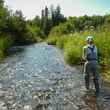






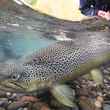




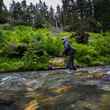




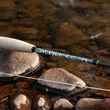




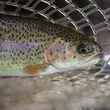



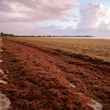
Comments